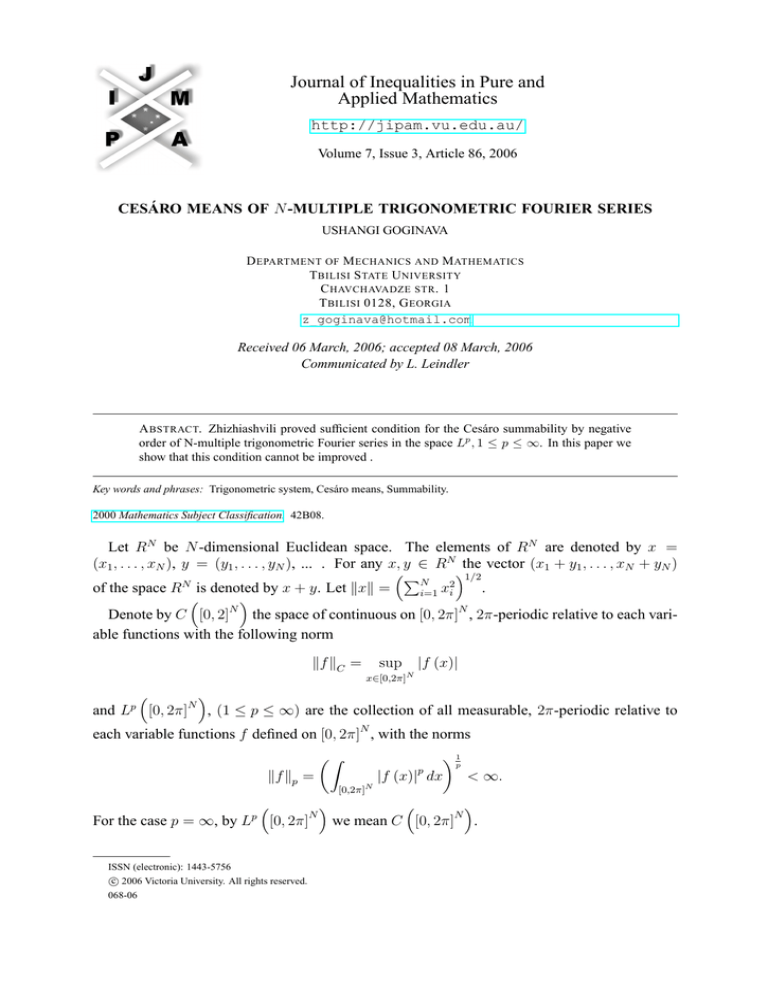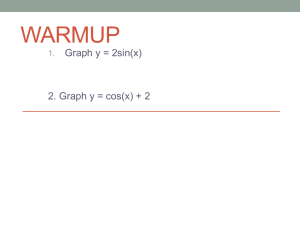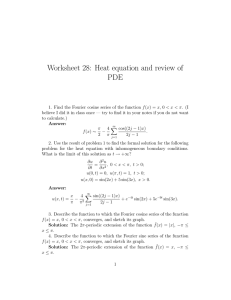
Journal of Inequalities in Pure and
Applied Mathematics
http://jipam.vu.edu.au/
Volume 7, Issue 3, Article 86, 2006
CESÁRO MEANS OF N -MULTIPLE TRIGONOMETRIC FOURIER SERIES
USHANGI GOGINAVA
D EPARTMENT OF M ECHANICS AND M ATHEMATICS
T BILISI S TATE U NIVERSITY
C HAVCHAVADZE STR . 1
T BILISI 0128, G EORGIA
z_goginava@hotmail.com
Received 06 March, 2006; accepted 08 March, 2006
Communicated by L. Leindler
A BSTRACT. Zhizhiashvili proved sufficient condition for the Cesáro summability by negative
order of N-multiple trigonometric Fourier series in the space Lp , 1 ≤ p ≤ ∞. In this paper we
show that this condition cannot be improved .
Key words and phrases: Trigonometric system, Cesáro means, Summability.
2000 Mathematics Subject Classification. 42B08.
Let RN be N -dimensional Euclidean space. The elements of RN are denoted by x =
(x1 , . . . , xN ), y = (y1 , . . . , yN ), ... . For any x, y ∈ RN the vector (x1 + y1 , . . . , xN + yN )
P
1/2
N
2
of the space RN is denoted by x + y. Let kxk =
x
.
i=1 i
Denote by C [0, 2]N the space of continuous on [0, 2π]N , 2π-periodic relative to each variable functions with the following norm
kf kC =
sup
|f (x)|
x∈[0,2π]N
and Lp [0, 2π]N , (1 ≤ p ≤ ∞) are the collection of all measurable, 2π-periodic relative to
each variable functions f defined on [0, 2π]N , with the norms
Z
kf kp =
p
|f (x)| dx
p1
< ∞.
[0,2π]N
For the case p = ∞, by Lp [0, 2π]N we mean C [0, 2π]N .
ISSN (electronic): 1443-5756
c 2006 Victoria University. All rights reserved.
068-06
2
U SHANGI G OGINAVA
Let M := {1, 2, . . . , N } , B := {s1 , . . . , sr } , sk < sk+1 , k = 1, . . . , r − 1, B ⊂ M,
B := M \B. Let
0
∆{si } (f, x, hsi ) := f (x1 , . . . , xsi −1 , xsi + hsi , xsi +1 , . . . , xN )
− f (x1 , . . . , xsi −1 , xsi , xsi +1 , . . . , xN ) .
The expression we get by successive application of operators ∆{s1 } (f, x, hs1 ) , . . . ,
∆
(f, x, hsr ) will be denoted by ∆B (f, x, hs1 , . . . , hsr ) , i. e.
∆B (f, x, hs1 , . . . , hsr ) := ∆{sr } ∆B\{sr } , x, hsr .
Let f ∈ Lp [0, 2π]N . The expression
B
∆ (f, ·, hs1 , . . . , hsr )
ωB (δs1 , . . . , δsr ; f ) :=
sup
p
|hsi |≤δsi ,i=1,...,r
{sr }
is called a mixed or a particular modulus of continuity in the Lp norm, when card(B) ∈ [2, N ]
or card(B) = 1.
The total modulus of continuity of the function f ∈ Lp [0, 2π]N in the Lp norm is defined
by
ω (δ, f )p = sup kf (· + h) − f (·)kp
(1 ≤ p ≤ ∞) .
khk≤δ
Suppose that f is a Lebesgue integrable function on [0, 2π]N , 2π periodic relative to each
variable.Then its N -dimensional Fourier series with respect to the trigonometric system is defined by
∞
∞
X
X
X (B)
Y
Y
···
2−λ(i)
ai1 ,...,iN
cos ij xj
sin ik xk ,
i1 =0
iN =0
where
(B)
ai1 ,...,iN
j∈B 0
B⊂M
Z
1
= N
π
f (x)
Y
k∈B
cos ij xj
j∈B 0
[0,2π]N
Y
sin ik xk dx
k∈B
is the Fourier coefficient of f and λ (i) is the number of those coordinates of the vector i :=
(i1 , . . . , iN ) which are equal to zero.
Let Sp1 ,...,pN (f, x) denote the (p1 , . . . , pN )-th rectangular partial sums of the N -dimensional
Fourier series with respect to the trigonometric system, i. e.
Sp1 ,...,pN (f, x) :=
p1
X
···
i1 =0
pN
X
Ai1 ,...,iN (f, x) ,
iN =0
where
Ai1 ,...,iN (f, x) := 2−λ(i)
X
(B)
ai1 ,...,iN
B⊂M
Y
cos ij xj
j∈B 0
Y
sin ik xk .
k∈B
The Cesáro (C; α1 , . . . , αN )-means of N -multiple trigonometric Fourier series defined by
!−1 m
mN Y
N
N
1
Y
X
X
α1 ,...,αN
αi
−1
σm1 ,...,mN (f, x) =
Ami
···
Aαmjj−
pj Sp1 ,...,pN (f, x) ,
i=1
p1 =0
pN =0 j=1
where
Aαn =
(α + 1) (α + 2) · · · (α + n)
,
n!
J. Inequal. Pure and Appl. Math., 7(3) Art. 86, 2006
α 6= −1, −2, . . . ,
n = 0, 1, . . . .
http://jipam.vu.edu.au/
C ESÁRO M EANS
3
It is well-known that [4]
c1 (α) nα ≤ Aαn ≤ c2 (α) nα .
(1)
For the uniform summability of Cesáro means of negative order of one-dimensional trigonometric Fourier series the following result of Zygmund [3] is well-known: if
ω (δ, f )C = o (δ α )
and α ∈ (0, 1), then the trigonometric Fourier series of the function f is uniformly (C, −α)
summable to f.
In [2] Zhizhiashvili proved sufficient conditions for the convergenceof Cesáro
means of negaN
p
tive order of N -multiple trigonometric Fourier series in the space L [0, 2π] , (1 ≤ p ≤ ∞).
The following is proved.
N
p
Theorem A (Zhizhiashvili). Let f ∈ L [0, 2π] for some p ∈ [1, +∞] and α1 + · · · + αN <
1, where αi ∈ (0, 1), i = 1, 2, . . . , N . If
ω (δ, f )p = o δ α1 +···+αN ,
then
−α ,...,−α
1
N
→0
σm ,...,m
(f
)
−
f
1
N
p
as
mi → ∞, i = 1, . . . , N.
In case p = ∞ the sharpness of Theorem A has been proved by Zhizhiashvili [2]. The
following theorem shows that Theorem A cannot be improved in cases 1 ≤ p < ∞. Moreover,
we prove the following
Theorem 1 (for N = 1 see [1]).Let α1 +· · · + αN < 1 and αi ∈ (0, 1), i = 1, 2, . . . , N, then
there exists the function f0 ∈ C [0, 2π]N for which
(2)
ω (δ, f0 )C = O δ α1 +···+αN
and
−α ,...,−α
1
N
lim σm,...,m
(f0 ) − f0 1 > 0.
m→∞
Proof. We can define the sequence {nk : k ≤ 1} satisfying the properties
∞
X
1
1
(3)
=O
,
nα1 +···+αN
nαk 1 +···+αN
j=k+1 j
(4)
k−1
X
1−(α +···+αN )
nj 1
=O
1−(α +···+αN )
nk 1
,
j=1
nk−1
1
< .
nk
k
(5)
Consider the function f0 defined by
f0 (x1 , . . . , xN ) :=
∞
X
fj (x1 , . . . , xN ) ,
j=1
where
fj (x1 , . . . , xN ) :=
J. Inequal. Pure and Appl. Math., 7(3) Art. 86, 2006
1
N
Y
nαj 1 +···+αN
i=1
sin nj xi .
http://jipam.vu.edu.au/
4
U SHANGI G OGINAVA
From (3) it is easy to show that f0 ∈ C [0, 2π]N . First we shall prove that
i = 1, . . . , N.
(6)
ωi (δ, f )C = O δ α1 +···+αN ,
Let
1
nk
≤δ<
1
.
nk−1
Then from (3) and (4) we can write that
|f0 (x1 , . . . , xi−1 , xi + δ, xi+1 , . . . , xN ) − f0 (x1 , . . . , xi−1 , xi , xi+1 , . . . , xN )|
∞
X
1
≤
α1 +···+αN |sin nj (xi + δ) − sin nj xi |
n
j=1 j
≤
≤
k−1
X
1
nα1 +···+αN
j=1 j
k−1
X
|sin nj (xi + δ) − sin nj xi | + 2
nj δ
nαj 1 +···+αN
+O
∞
X
1
nα1 +···+αN
j=k j
1
nαk 1 +···+αN
1
1−(α1 +···+αN )
= O δnk−1
+O
nαk 1 +···+αN
= O δ α1 +···αN ,
j=1
which proves (6).
Since
ω (δ, f )C ≤
N
X
ωi (δ, f )C ,
i=1
we obtain the proof of estimation (2).
N
−α1 ,...,−αN
1
Next we shall prove that σnk ,...,nk
(f0 ) diverge in the metric of L [0, 2π] . It is clear
that
−α ,...,−α
1
N
σn ,...,n
(f
)
−
f
(7)
0
0
k −αk,...,−α
1
1
N
≥ σnk ,...,n
(fk )1
k
k−1
∞
∞
X
X
X
−α ,...,−α
−α ,...,−α
1
1
N
N
−
σnk ,...,nk
(fj ) − fj C −
σnk ,...,nk
(fj ) C −
kfj kC
j=1
j=k+1
j=k
= I − II − III − IV.
It is evident that
(8)
1 ,...,−αN
σn−α
(fj ) = 0,
k ,...,nk
j = k + 1, k + 2, . . . .
Using (3) for IV we have
(9)
IV ≤
∞
X
1
j=k
nαj 1 +···+αN
=O
1
.
nαk 1 +···+αN
Since [2]
−α ,...,−α
1
N
σn ,...,n
=O
(f
)
−
f
j
j
k
k
C
X
ωB
B⊂M
1
, fj
nk
and
ωi
1
, fj
nk
J. Inequal. Pure and Appl. Math., 7(3) Art. 86, 2006
=O
1
nαj 1 +···+αN
nj
nk
P
αs
!
ns∈B
k
C
!
,
http://jipam.vu.edu.au/
C ESÁRO M EANS
5
from (4) and (5) we get
(10)
II = O
k−1
X
1
1−(α1 +···+αN )
nk
=O
j=1
k−2
X
1
1−(α +···+αN )
nk 1
j=1
1−(α1 +···+αN )
=O
!
1−(α +···+αN )
nj 1
nk−1
1−(α1 +···+αN )
1−(α1 +···+αN )
nj
!
1−(α1 +···+αN )
nk
!
1−(α +···+α )
N
nk 1
1−(α1 +···+αN ) !
1
=O
= o (1)
k
Since
+
nk−1
as
k → ∞.
(B)
and
(M )
ai1 ,...,iN
ai1 ,...,iN (fk ) = 0, for B ⊂ M, B 6= M
−α −···−α
N
, for i1 = · · · = iN = nk ;
nk 1
(fk ) =
0,
otherwise,
from (1) we have
−α ,...,−α
1
N
σn ,...,n
(11)
(fk )1
k
k
Z 2π
Z 2π
−α ,...,−α
1
N
σn ,...,n
=
···
(fk ; x1 , . . . , xN ) dx1 · · · dxN
k
k
0
Z0
Z 2π
N
2π
Y
−α1 ,...,−αN
≥
···
σnk ,...,nk
(fk ; x1 , . . . , xN )
sin nk xi dx1 · · · dxN 0
0
i=1
nk
nk Y
N
1
X
1 X
1 −1
···
= −α1 · · · −αN
A−α
nk− ij
Ank
Ank i =0
iN =0 j=1
1
Z 2π
Z 2π
N
Y
×
···
Si1 ,...,iN (fk ; x1 , . . . , xN )
sin nk xi dx1 · · · dxN 0
0
i=1
1
1
)
· · · −αN a(M
nk ,...,nk (fk )
1
A−α
Ank
nk
1
1
1 −···−αN
= π N −α1 · · · −αN n−α
≥ c (α1 , . . . , αN ) > 0.
k
Ank
Ank
Combining (7) – (11) we complete the proof of Theorem 1.
= πN
R EFERENCES
[1] U. GOGINAVA, Cesáro means of trigonometric Fourier series, Georg. Math. J., 9 (2002), 53–56.
[2] L.V. ZHIZHIASHVILI, Trigonometric Fourier Series and their Conjugates, Kluwer Academic Publishers, Dobrecht, Boston, London, 1996.
[3] A. ZYGMUND, Sur la sommabilite des series de Fourier des functions verfiant la condition de
Lipshitz, Bull. de Acad. Sci. Ser. Math. Astronom. Phys., (1925), 1–9.
[4] A. ZYGMUND, Trigonometric Series, Vol. 1, Cambridge Univ. Press, 1959.
J. Inequal. Pure and Appl. Math., 7(3) Art. 86, 2006
http://jipam.vu.edu.au/






